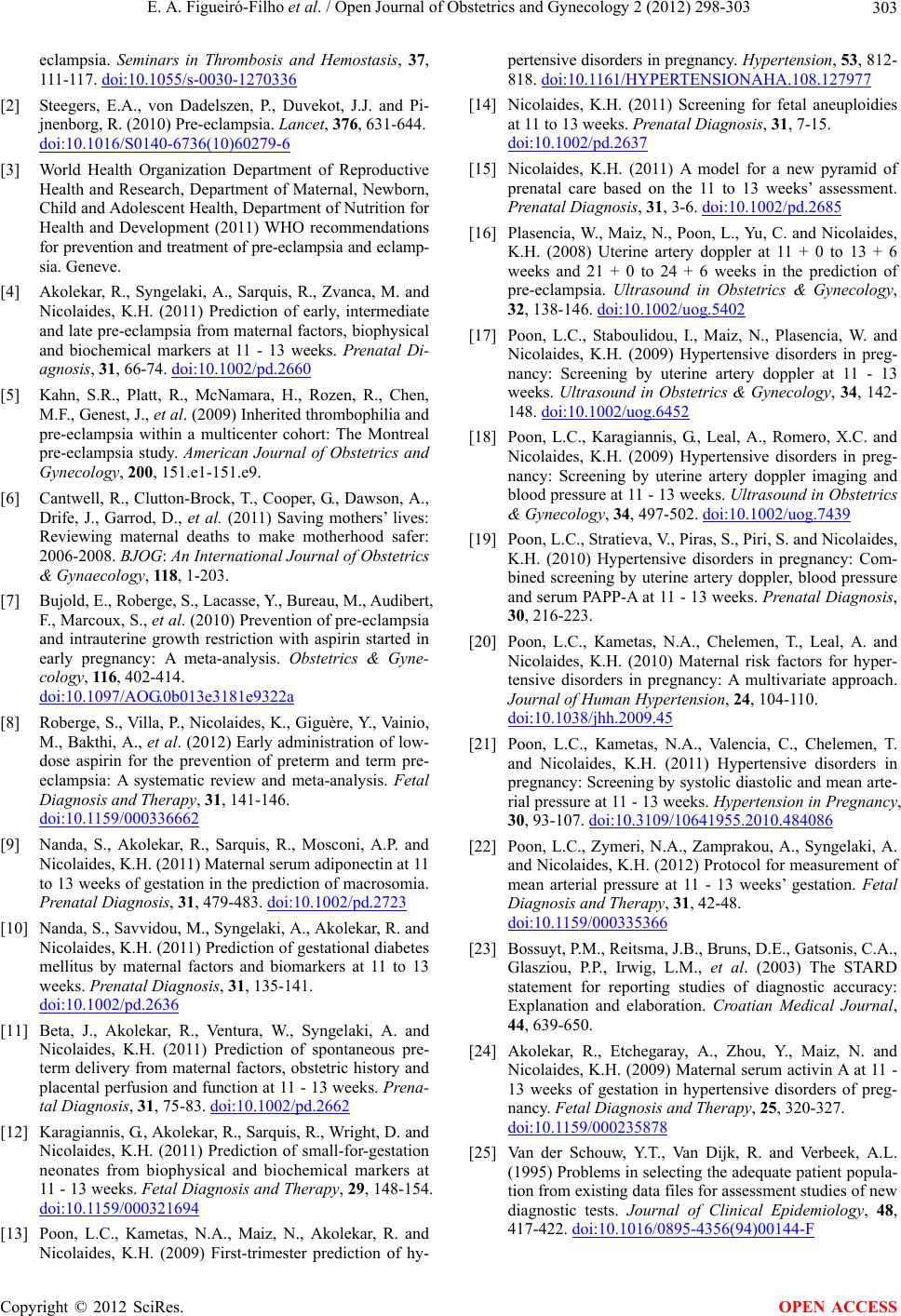
E. A. Figueiró-Filho et al. / Open Journal of Obstetrics and Gynecology 2 (2012) 298-303 303
eclampsia. Seminars in Thrombosis and Hemostasis, 37,
111-117. doi:10.1055/s-0030-1270336
[2] Steegers, E.A., von Dadelszen, P., Duvekot, J.J. and Pi-
jnenborg, R. (2010) Pre-eclampsia. Lancet, 376, 631-644.
doi:10.1016/S0140-6736(10)60279-6
[3] World Health Organization Department of Reproductive
Health and Research, Department of Maternal, Newborn,
Child and Adolescent Health, Department of Nutrition for
Health and Development (2011) WHO recommendations
for prevention and treatment of pre-eclampsia and eclamp-
sia. Geneve.
[4] Akolekar, R., Syngelaki, A., Sarquis, R., Zvanca, M. and
Nicolaides, K.H. (2011) Prediction of early, intermediate
and late pre-eclampsia from maternal factors, biophysical
and biochemical markers at 11 - 13 weeks. Prenatal Di-
agnosis, 31, 66-74. doi:10.1002/pd.2660
[5] Kahn, S.R., Platt, R., McNamara, H., Rozen, R., Chen,
M.F., Genest, J., et al. (2009) Inherited thrombophilia and
pre-eclampsia within a multicenter cohort: The Montreal
pre-eclampsia study. American Journal of Obstetrics and
Gynecology, 200, 151.e1-151.e9.
[6] Cantwell, R., Clutton-Brock, T., Cooper, G., Dawson, A.,
Drife, J., Garrod, D., et al. (2011) Saving mothers’ lives:
Reviewing maternal deaths to make motherhood safer:
2006-2008. BJOG: An International Journal of Obstetrics
& Gynaecology, 118, 1-203.
[7] Bujold, E., Roberge, S., Lac a sse, Y., Bure au, M., Audibert,
F., Marcoux, S., et al. (2010) Prevention of pre-eclampsia
and intrauterine growth restriction with aspirin started in
early pregnancy: A meta-analysis. Obstetrics & Gyne-
cology, 116, 402-414.
doi:10.1097/AOG.0b013e3181e9322a
[8] Roberge, S., Villa, P., Nicolaides, K., Giguère, Y., Vainio,
M., Bakthi, A., et al. (2012) Early administration of low-
dose aspirin for the prevention of preterm and term pre-
eclampsia: A systematic review and meta-analysis. Fetal
Diagnosis and Therapy, 31, 1 4 1-146.
doi:10.1159/000336662
[9] Nanda, S., Akolekar, R., Sarquis, R., Mosconi, A.P. and
Nicolaides, K.H. (2011) Maternal serum adiponectin at 11
to 13 weeks of gestation in the prediction of macrosomia.
Prenatal Diagnosis, 31, 479-483. doi:10.1002/pd.2723
[10] Nanda, S., Savvidou, M., Syngelaki, A., Akolekar, R. and
Nicolaides, K.H. (2011) Prediction of gestational diabetes
mellitus by maternal factors and biomarkers at 11 to 13
weeks. Prenatal Diagnosi s, 31, 135-141.
doi:10.1002/pd.2636
[11] Beta, J., Akolekar, R., Ventura, W., Syngelaki, A. and
Nicolaides, K.H. (2011) Prediction of spontaneous pre-
term delivery from maternal factors, obstetric history and
placental perfusion and function at 11 - 13 weeks. Prena-
tal Diagnosis, 31, 75-83. doi:10.1002/pd.2662
[12] Karagiannis, G., Akolekar, R., Sarquis, R., Wright, D. and
Nicolaides, K.H. (2011) Prediction of small-for-gestation
neonates from biophysical and biochemical markers at
11 - 13 weeks. Fetal Diagnosis and Therapy, 29, 148-154.
doi:10.1159/000321694
[13] Poon, L.C., Kametas, N.A., Maiz, N., Akolekar, R. and
Nicolaides, K.H. (2009) First-trimester prediction of hy-
pertensive disorders in pregnancy. Hypertension, 53, 812-
818. doi:10.1161/HYPERTENSIONAHA.108.127977
[14] Nicolaides, K.H. (2011) Screening for fetal aneuploidies
at 11 to 13 weeks. Prenatal Diagnosis, 31, 7-15.
doi:10.1002/pd.2637
[15] Nicolaides, K.H. (2011) A model for a new pyramid of
prenatal care based on the 11 to 13 weeks’ assessment.
Prenatal Diagnosis, 31, 3-6. doi:10.1002/pd.2685
[16] Plasencia, W., Maiz, N., Poon, L., Yu, C. and Nicolaides,
K.H. (2008) Uterine artery doppler at 11 + 0 to 13 + 6
weeks and 21 + 0 to 24 + 6 weeks in the prediction of
pre-eclampsia. Ultrasound in Obstetrics & Gynecology,
32, 138-146. doi:10.1002/uog.5402
[17] Poon, L.C., Staboulidou, I., Maiz, N., Plasencia, W. and
Nicolaides, K.H. (2009) Hypertensive disorders in preg-
nancy: Screening by uterine artery doppler at 11 - 13
weeks. Ultrasound in Obstetrics & Gynecology, 34, 142-
148. doi:10.1002/uog.6452
[18] Poon, L.C., Karagiannis, G., Leal, A., Romero, X.C. and
Nicolaides, K.H. (2009) Hypertensive disorders in preg-
nancy: Screening by uterine artery doppler imaging and
blood pressure at 11 - 13 weeks. Ultrasound in Obstetrics
& Gynecology, 34, 497-502. doi:10.1002/uog.7439
[19] Poon, L.C., Stratieva, V., Piras, S., Piri, S. and Nicolaides,
K.H. (2010) Hypertensive disorders in pregnancy: Com-
bined screening by uterine artery doppler, blood pressure
and serum PAPP-A at 11 - 13 weeks. Prenatal Diagnosis,
30, 216-223.
[20] Poon, L.C., Kametas, N.A., Chelemen, T., Leal, A. and
Nicolaides, K.H. (2010) Maternal risk factors for hyper-
tensive disorders in pregnancy: A multivariate approach.
Journal of Human Hypertension, 24, 104-110.
doi:10.1038/jhh.2009.45
[21] Poon, L.C., Kametas, N.A., Valencia, C., Chelemen, T.
and Nicolaides, K.H. (2011) Hypertensive disorders in
pregnancy: Screening by systolic diastolic and mean arte-
rial pressure at 11 - 13 weeks. Hypertension in Pregnancy,
30, 93-107. doi:10.3109/10641955.2010.484086
[22] Poon, L.C., Zymeri, N.A., Zamprakou, A., Syngelaki, A.
and Nicolaides, K.H. (2012) Protocol for measurement of
mean arterial pressure at 11 - 13 weeks’ gestation. Fetal
Diagnosis and Therapy, 31, 42-48.
doi:10.1159/000335366
[23] Bossuyt, P.M., Reitsma, J. B., Bruns, D.E., Gatsonis, C.A.,
Glasziou, P.P., Irwig, L.M., et al. (2003) The STARD
statement for reporting studies of diagnostic accuracy:
Explanation and elaboration. Croatian Medical Journal,
44, 639-650.
[24] Akolekar, R., Etchegaray, A., Zhou, Y., Maiz, N. and
Nicolaides, K.H. (2009) Maternal serum activin A at 11 -
13 weeks of gestation in hypertensive disorders of preg-
nancy. Fetal Diagnosis and Therapy, 25, 320-327.
doi:10.1159/000235878
[25] Van der Schouw, Y.T., Van Dijk, R. and Verbeek, A.L.
(1995) Problems in selecting the adequate patient popula-
tion from existing data files for assessment studies of new
diagnostic tests. Journal of Clinical Epidemiology, 48,
417-422. doi:10.1016/0895-4356(94)00144-F
Copyright © 2012 SciRes. OPEN ACCESS